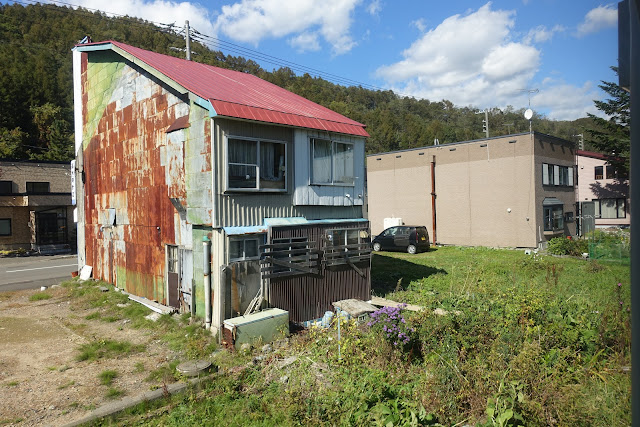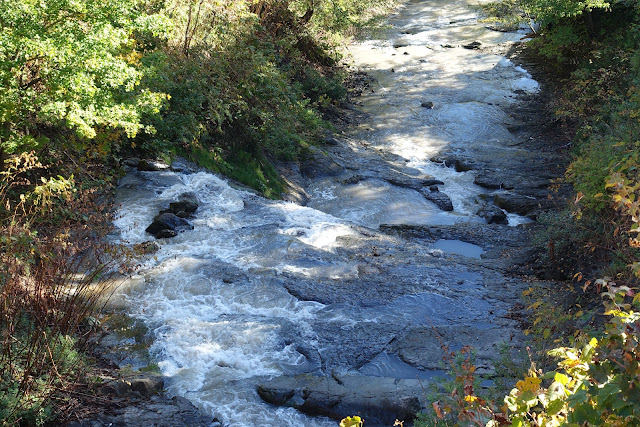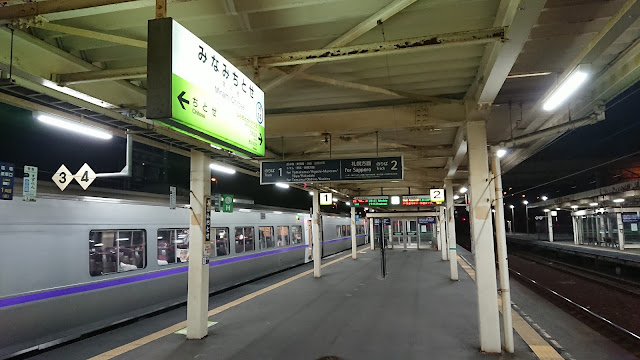There is a war going on in Australia right now between right wing conservatives, for whom continued coal usage is a symbol of their fear of change, and those who know that we must stop burning fossil fuels for the sake of the future. Despite the role coal has played in the ushering in of the Industrial Revolution, the evidence suggests that not only is coal bad for the environment, is is a bad investment as well with renewable energy becoming increasingly cheaper.
While the benefits for society as a whole are clear, this change does not come without cost. Today, I will see the aftermath of such change.
One of the major destinations of Australian coal is Japan, but once it was mined here as well. One of the best known examples was the now abandoned Hashiman Island, but I'm headed to Yubari in Hokkaido.
I was introduced to Yubari by a couple of posts at Spike Japan, often a commemoration of dying Japan, and have long wanted to go. Now with a fixed date for the closure of the railway line to the town, 31 March 2019, I had to.
The first step is for us to get to Hokkaido. I'm finally going to bite the bullet and take only my third domestic flight in Japan and save the long hours of the train up to Sapporo. I've done that route far too often lately.
After a rather nice hot buffet breakfast we are rather sad to farewell the Hatago Inn. The beds were comfy, the staff friendly, especially the young Bolivian expatriate, and there were even English manga comics to read. I recognised some of the titles from film adaptations, though sadly I've never actually read one.
Back across the bridge to Kansai Airport, then off to the Jetstar counters. Yes, not trying anything new, with both our previous flight in Japan with Jetstar, so familiar from Australia. But I was nervous enough and anyway, we earn points with them.
I'd checked in using the Jetstar app on my phone, but still need to check in our luggage. There's no conveyor belt from the check in desk, you need to carry your bags to the security screening yourself.
Prior to our own screening Alex gets stuck watching a video of a couple of westerners investigating Japanese toilets.
Our aircraft is waiting at a remote stand and we have to catch a bus out to it. Waiting nearby is a Russian government Illyushin IL-96, the first I've ever seen.
We board up covered stairs in spitting rain and take our seat together in a cabin that could be from any of our countless other Jetstar A320 flights except that the printed materials are primarily in Japanese.
Then the cabin manager makes an announcement that sends shivers down my spine.
"As we are expecting turbulence on this flight please use the bathrooms before now."
What???
Are you saying use them now because the seatbelt lights will be on and you can't get up, or because it's better for those with weak stomachs to empty them now before it becomes involuntary during turbulence?
My flight is spoiled now. I want to get off.
Outside the sky doesn't look scary. High grey cloud, some gentle rain, no wind, clear skies predicted over Hokkaido. Is it the jetstream? A front? Something related to Typhoon Number 25?
I am stuck.
We taxi out to the runway and quickly the engines spool up to full power and we are up and away.
There are views of the area around the bay before we hit the grey layers of cloud above. As suspected, the are ethereal and do not present anything more than a few minor bumps.
For maybe half an hour we cruise through the grey before emerging above it. The seat belt lights are switched off, though it actually gets bumpier once they are.
I wonder if it is just about the high cloud, or maybe even a ploy to keep people in their seats.
Cabin service begins and we have a 1,500 yen credit thanks to the add on we purchased. We spend it on Jetstar doryaki, red bean pancakes, juice and Pringle's.
Without a flight map it's difficult to tell where we are, but there are some fine views of the western Japanese coastline. We cross the north of Tohoku, then swing back around to Hokkaido from the south east.
There's only scattered cloud over the mountainous countryside and this disappears as we cross the coast. The descent is over water and the coastal Plains near Tomokomai until, at last, we touch down at New Chitose Airport.
The international terminal is large and rounded and, for some reason, reminds me of Melbourne's Tullamarine.
We exit quickly, which suddenly opens up a new option for the day's plans. There's enough time, just, to catch the next train to Yubari instead of going to Sapporo first.
Unfortunately there's is not enough time to explain properly to B and Alex, who were just going to spend the afternoon in Hokkaido's biggest city while I went off to one headed the other direction.
The airport service lasts just one stop to Minami Chitose, where we change for an express. Outside we pass fields of corn and other crops, forests with touches of Autumn in their leaves.
Leaving the train at Shin-Yubari, the others look at me with a sense of dread. The station is decrepit and isolated.
Eventually the connecting service, a single KiHa 47 rail car, pulls up. We are not the only ones boarding.
It is a reasonably long ride, though the distance is not great. I'm in my element at the end of the train, photographing, videoing. I'm not alone, either. Everyone seems to be a closet (or open) densha otaku in Japan. Outside I notice a man in a Mini stopping to take photos of the train from various vantage points along the route.
The single track passes through some pretty countryside as it winds its way higher into the mountains. Towns along the way are worse for wear, and many train waiting rooms have seen better days.
The station building is a quaint little church replica, complete with steeple, housing a closed tourist information office and cafe that also sells souvenirs.
A huge hotel, like a giant ship incongruously moored on land, stands adjacent to the station. The Hotel Racey has direct access both to the station and to the ski slopes beside, but the chairlifts stand motionless and the snow is freshly mown grass. There's a hot spa bath inside and I had thought of booking us a night there, but couldn't make it work.
Also adjacent to the station, but on the other side, is the Yubari Yattai, a wooden hut housing a number of eateries. It's busy at lunch and we decide to join them.
Ordering is a bit confusing as we are unsure who looks after what, the tables common to all. Eventually we choose three different bowls of ramen. They take over half an hour to arrive, the elderly lady a bit confused by it all, as were some of the Chinese tourists.
The shoyu, miso, and salt ramen are all really tasty, a reminder of how good ramen can be. My last ramen, eaten in Sydney at an old favourite now changed hands, was simply terrible.
The return train doesn't leave until around 4.30 so we have plenty of time to kill and little idea how to kill it.
We think of walking to the coal mining museum and set off up the hill under clear and quite warm skies. It's a wonderful day to be outside.
The number of abandoned buildings is astounding. The last of the coal mines closed in the 1990's after a couple of major accidents, coupled with a change of policy on energy supply. As well, the open cut mines of Australia and other countries could supply coal cheaper than the tunnels of Japan, rendering the business uneconomic.
As a consequence of the closures the population of the region plummeted more than tenfold, down from around 120,000 to around 10,000. Those that remain are heavily skewed towards the elderly demographic.
We pass the local government offices, an impressively large building with people going about their business inside, connected to another, the City Hall, that appears decrepit and abandoned. Others have weeds growing in front of their doors or collapsed roofs.
Crows wheel above, cawing like carrion birds over a carcass. Dragonflies buzz, conjoining for the next generation, more positive about their future than the human residents. The town is in a river valley and there is the sound of rushing water below the steep forested embankments.
We make it almost as far as the Racey's sister hotel, the Shuparo, before Alex and B decide to head back. I want to take a different path across the other side of the river and I'm glad I do.
This is the centre of town and although many buildings here too are abandoned, others still cling to life. The post office, hairdressers with the twirling red and blue spiral pole are standard for Japanese towns. The music shop selling compact discs and guitars seems the hopeful to me. On the sides of many are large paintings of historical movie posters, both Western and Japanese. Read the older Spike Japan article for the context.
A pond has a polished chrome sculpture in the middle, a cousin perhaps of those appearing around the Hotel Racey. A new looking bright yellow bar and adjacent restaurants are in Stark contrast to the collapsing buildings higher up the slopes. A closed school has farewell messages outside, but is being used for something.

I'm enjoying this walk, this town. Though there is much decay here I can imagine the stories that each place holds, uncrowded by the living.
I meet B and Alex near the Hotel Racey, having bought ice creams from the Seicomart kombini only to discover them already eating some.
Faced with over an hour's wait still for the next train we ask the hotel to book us a taxi to the Museum of Coal Mining.
When we arrive the attendant warns us that they will begin closing soon, but Alex and I decide to go through anyway.
The first two levels are mainly photographs and artefacts associated with the mines and the development of the town. English labels are very basic but you do get a sense of the changes through history.
We then descend via a lift that makes out it is travelling deep into the Earth. Emerging into a mine tunnel we pass displays of manikins and machinery displaying mining through the ages.
Alex gets a huge shock when he presses a button and the mining conveyor belt comes noisily to life.
Climbing deeper into the mine tunnels we observed how the coal was extracted and brought to the surface. Alex felt a bit nervous now.
We had to hurry through as an attendant was walking behind us shutting the exhibits down for the day. The exit is quite far from the entrance and we had to walk up the hill again to retrieve B and our bags. The lady inside was kind enough to book another taxi back to the station.
I'm glad we visited the museum as it was actually really interesting despite the lack of English signage. That's pretty much where coal mining belongs now. In a museum. But it's important for younger generations to know the role it played.
Fortunately the train that returns us from Yubari rides all the way to Minami Chitose, so there is only one change of train to take us to Sapporo. I admire the black silhouettes of hills, trees and poles as we race back against the dim orange sky.
We are all tired and Alex and B are quite unhappy that I dragged them to Yubari.
Back in Sapporo, we dump our bags at the hotel and race back to the station and adjacent shopping centre. Alex has said he wants sushi again so we go join the queue at Nemuro Hanamaru Sushi, taking a number, sitting outside while yet more tourists arrive.
By the time we get a seat Alex is so tired that he doesn't eat much. We enjoy some very nice fresh seafood, although sashimi really is wasted on me.
We are are all absolutely knackered when we return to the hotel, but I'm glad I visited Yubari. I don't think I'll have that opportunity ever again. It was a lesson worth learning, that change is inevitable, but that we still need to care for those that it affects.
















































































Comments